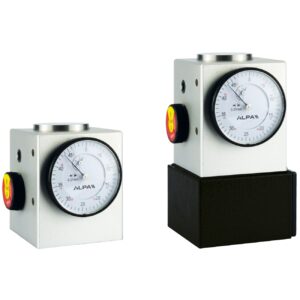Calipers and centring devices: essential tools for the mechanical industry
In the mechanical industry, precision is a crucial element that determines the quality and efficiency of production processes. Zero-setters and centring devices are essential tools that help ensure this precision, playing a key role in machining operations. These devices are designed to improve the accuracy and reliability of machine tools, enabling operators to achieve optimum results in terms of quality and productivity.
What are zeroers and centring devices?
Setters and centring devices are tools that are mainly used in machine shops to ensure the alignment and centring of workpieces. Setters, also known as touch probes, are devices that enable the position of a workpiece in relation to the axes of the machine tool to be precisely determined. This is essential to correctly set the starting point of the machining process, avoiding errors that could compromise the entire process.
Centring devices, on the other hand, are tools used to ensure that the workpiece is perfectly centred with respect to the machining tool. This is particularly important in turning and milling operations, where a misalignment could lead to defects in the finished product or even damage the machine.
The importance of precision in machining
Precision is a key aspect in machining, as it directly influences the quality of the end product. An error of a few millimetres can compromise the entire production process, causing scrap and increasing production costs. Zero-setters and centring devices help minimise these errors, ensuring that each part is machined with the highest possible accuracy.
The use of these tools reduces machine setup times, improving the overall efficiency of the production process. In addition, the accuracy guaranteed by the zero-setters and centring devices helps to extend the life of machine tools, reducing tool wear and minimising the need for maintenance.
How are setters and centring devices used?
The use of tool setters and centring devices requires specific technical skills and a good knowledge of machine tools. Tool setters are generally mounted on the machine spindle and used to probe the surface of the workpiece. Once the exact position of the workpiece has been determined, the operator can set the machining parameters precisely, ensuring that the tool starts working at the correct point.
Centring tools, on the other hand, are used to align the workpiece with respect to the tool. This can be done manually, using measuring instruments such as dial gauges or calipers, or automatically, using centring systems built into modern machine tools. In both cases, the aim is to ensure that the part is perfectly centred, avoiding misalignments that could compromise machining quality.
Advantages of using zeroers and centring devices
The adoption of zero-setters and centring devices in machine shops offers numerous advantages, including:
1. Improved product quality: The precision guaranteed by these tools translates into higher quality of the final product, reducing the risk of defects and rejects.
2. Increased production efficiency: By reducing setup times and minimising machining errors, zeroing and centring tools help improve the overall efficiency of the production process.
3. Reduced production costs: Reduced scrap and reduced machine downtime result in a significant reduction in production costs.
4. Prolonged machine tool life: The precision guaranteed by these tools reduces tool wear and minimises the need for maintenance, prolonging machine life.
5. Increased operational safety: The use of zero-setters and centring devices reduces the risk of human error, improving operational safety in machine shops.
Frequently asked questions about zero-setters and centring devices
1. What are the main types of zero-setters available on the market?
There are different types of zeroers, including mechanical, electronic and optical zeroers. Mechanical datums are the most common and use a system of levers and springs to determine the position of the part. Electronic zeroers, on the other hand, use electronic sensors to detect position, offering greater accuracy. Optical zeroers use light to determine the position of the part, offering high accuracy and speed.
2. How do I choose the most suitable centring tool for my needs?
The choice of a centring tool depends on several factors, including the type of machining operation, the size of the workpiece and the level of accuracy required. It is important to evaluate the technical specifications of the centring tool, such as centring capacity, accuracy and ease of use, to ensure that it meets your operational needs.
3. Can zero-setters and centring devices be used on CNC machine tools?
Yes, zeroers and centring devices can be used on CNC machine tools to improve the accuracy and efficiency of machining operations. Many modern CNC machines are equipped with integrated zeroing and centring systems, which can automate the process and reduce setup times.
4. What are the main challenges in using zeroing and centring?
One of the main challenges in using zeroers and centrators is ensuring that they are correctly calibrated and maintained. Incorrect calibration can compromise machining accuracy, leading to errors and defects in the final product. It is important to follow the manufacturer's instructions for calibrating and maintaining the instruments, ensuring that they are always in optimal condition.
5. What are the future trends in the field of zeroers and centring devices?
Future trends in the field of zeroers and centrators include the development of increasingly accurate and automated instruments that integrate with digital technologies and Industry 4.0. The adoption of advanced sensors and artificial intelligence systems will further improve the accuracy and efficiency of machining operations, opening up new opportunities for the mechanical industry.
In conclusion, zero-setters and centring devices are essential tools for ensuring the accuracy and efficiency of machining operations. Their adoption in machine shops offers numerous benefits, helping to improve product quality, reduce production costs and increase operational safety. As technologies evolve and integrate with Industry 4.0, these tools will continue to play a crucial role in the future of the mechanical engineering industry.
Showing the single result
